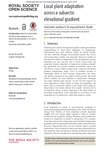Please use this identifier to cite or link to this item:
http://lib.hpu.edu.vn/handle/123456789/22256Full metadata record
| DC Field | Value | Language |
|---|---|---|
| dc.contributor.author | Kardol, Jonathan Paul | en_US |
| dc.date.accessioned | 2016-07-18T06:49:05Z | |
| dc.date.available | 2016-07-18T06:49:05Z | |
| dc.date.issued | 2014 | en_US |
| dc.identifier.other | HPU4160415 | en_US |
| dc.identifier.uri | https://lib.hpu.edu.vn/handle/123456789/22256 | en_US |
| dc.description.abstract | Predicting how plantswill respond to global warming necessitates understanding of local plant adaptation to temperature. Temperature may exert selective effects on plants directly, and also indirectly through environmental factors that covary with temperature, notably soil properties. However, studies on the interactive effects of temperature and soil properties on plant adaptation are rare, and the role of abiotic versus biotic soil properties in plant adaptation to temperature remains untested. | en_US |
| dc.format.extent | 9 p. | en_US |
| dc.format.mimetype | application/pdf | en_US |
| dc.language.iso | en | en_US |
| dc.subject | Ecology | en_US |
| dc.subject | Aboveground–belowground linkages | en_US |
| dc.subject | Bistorta | en_US |
| dc.subject | Vivipara | en_US |
| dc.subject | Climate change | en_US |
| dc.subject | Ecotypic variation | en_US |
| dc.subject | Global warming | en_US |
| dc.subject | Plant–soil interactions | en_US |
| dc.title | Local plant adaptation across a subarctic elevational gradient | en_US |
| dc.type | Article | en_US |
| dc.size | 625KB | en_US |
| dc.department | Education | en_US |
| Appears in Collections: | Education | |
Files in This Item:
| File | Description | Size | Format | |
|---|---|---|---|---|
| 0298_Localplantadaptationacross.pdf Restricted Access | 625.29 kB | Adobe PDF |  View/Open Request a copy |
Items in DSpace are protected by copyright, with all rights reserved, unless otherwise indicated.
